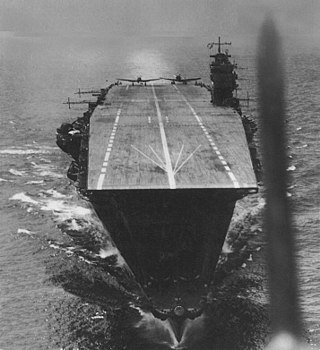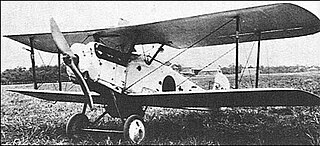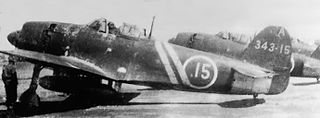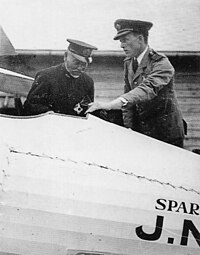
Kaga (加賀) was an aircraft carrier built for the Imperial Japanese Navy (IJN) and was named after the former Kaga Province in present-day Ishikawa Prefecture. Originally intended to be one of two Tosa-class battleships, Kaga was converted under the terms of the Washington Naval Treaty to an aircraft carrier as the replacement for the battlecruiser Amagi, which had been irreparably damaged during the 1923 Great Kantō earthquake. Kaga was rebuilt in 1933–1935, increasing her top speed, improving her exhaust systems, and adapting her flight decks to accommodate more modern, heavier aircraft.

Akagi was an aircraft carrier built for the Imperial Japanese Navy (IJN), named after Mount Akagi in present-day Gunma Prefecture. Though she was laid down as an Amagi-class battlecruiser, Akagi was converted to an aircraft carrier while still under construction to comply with the terms of the Washington Naval Treaty. The ship was rebuilt from 1935 to 1938 with her original three flight decks consolidated into a single enlarged flight deck and an island superstructure. The second Japanese aircraft carrier to enter service, and the first large or "fleet" carrier, Akagi and the related Kaga figured prominently in the development of the IJN's new carrier striking force doctrine that grouped carriers together, concentrating their air power. This doctrine enabled Japan to attain its strategic goals during the early stages of the Pacific War from December 1941 until mid-1942.

The Imperial Japanese Navy was the navy of the Empire of Japan from 1868 to 1945, when it was dissolved following Japan's surrender in World War II. The Japan Maritime Self-Defense Force (JMSDF) was formed between 1952 and 1954 after the dissolution of the IJN.

Hōshō was the world's first commissioned ship that was built as an aircraft carrier, and the first aircraft carrier of the Imperial Japanese Navy (IJN). Commissioned in 1922, the ship was used for testing carrier aircraft operations equipment, techniques, such as take-offs and landings, and carrier aircraft operational methods and tactics. The ship provided valuable lessons and experience for the IJN in early carrier air operations. Hōshō's superstructure and other obstructions to the flight deck were removed in 1924 on the advice of experienced aircrews.
This is a list of aviation-related events from 1921:

Takijirō Ōnishi was an admiral in the Imperial Japanese Navy during World War II who came to be known as the father of the kamikaze.

Naval aviation is the application of military air power by navies, whether from warships that embark aircraft, or land bases.

The Imperial Japanese Navy Air Service (IJNAS) was the air arm of the Imperial Japanese Navy (IJN). The organization was responsible for the operation of naval aircraft and the conduct of aerial warfare in the Pacific War.
During World War II, at the beginning of the Pacific War in December 1941, the Imperial Japanese Navy (IJN) was the third most powerful navy in the world, and the naval air service was one of the most potent air forces in the world. During the first six months of the war, the IJN enjoyed spectacular success inflicting heavy defeats on Allied forces, being undefeated in every battle. The attack on Pearl Harbor crippled the battleships of the US Pacific Fleet, while Allied navies were devastated during Japan's conquest of Southeast Asia. Japanese Navy aircraft operating from land bases were also responsible for the sinkings of HMS Prince of Wales and HMS Repulse which was the first time that capital ships were sunk by aerial attack while underway. In April 1942, the Indian Ocean raid drove the Royal Navy from South East Asia. After these successes, the Japanese now concentrated on the elimination and neutralization of strategic points from where the Allies could launch counteroffensives against Japan's conquests. However, at Coral Sea the Japanese were forced to abandon their attempts to isolate Australia while the defeat at Midway saw them forced on the defensive. The campaign in the Solomon Islands, in which the Japanese lost the war of attrition, was the most decisive; they had failed to commit enough forces in sufficient time.

Ryūnosuke Kusaka, was an admiral in the Imperial Japanese Navy during World War II who served as Chief of Staff of the Combined Fleet. Fellow Admiral Jinichi Kusaka was his cousin. Kusaka was also the 4th Headmaster of Ittō Shōden Mutō-ryū Kenjutsu, a famous school of swordsmanship founded by Yamaoka Tesshū.

Zuihō was the name ship of her class of two light aircraft carriers built for the Imperial Japanese Navy. Originally laid down as the submarine tender Takasaki, she was renamed and converted while under construction into an aircraft carrier. The ship was completed during the first year of World War II and played a minor role in the Battle of Midway in mid-1942. She participated in the Guadalcanal Campaign during the rest of 1942. Significantly damaged during the Battle of the Santa Cruz Islands in that campaign, after repairs Zuihō covered the evacuation of Japanese forces from Guadalcanal in early 1943.

The Decisive Battle Doctrine was a naval strategy adopted by the Imperial Japanese Navy prior to the Second World War. The theory was derived from the writings of American naval historian Alfred Thayer Mahan. In the Decisive Battle Doctrine the Japanese navy would win a war by fighting and winning a single, decisive naval action. The idea gained broad acceptance following the Russo-Japanese War, where a well-trained, smaller Japanese naval force gained a decisive victory in the Sea of Japan at the Battle of Tsushima, defeating the Imperial Russian Navy of their rival the Russian Empire, a western naval power. Operational plans thereafter were influenced by the effective naval gunnery Japan demonstrated at Tsushima.

The Mitsubishi 1MF was a Japanese carrier fighter aircraft of the 1920s. Designed for the Mitsubishi Aircraft Company by the British aircraft designer Herbert Smith, the 1MF, also known as the Navy Type 10 Carrier Fighter was operated by the Imperial Japanese Navy from 1923 to 1930.

The Gloster Sparrowhawk was a single-seat fighter aircraft designed and produced during the early 1920s by the British aircraft manufacturer Gloster.

William Francis Forbes-Sempill, 19th Lord Sempill,, was a Scottish peer and record-breaking air pioneer, who was later shown to have passed secret information to the Imperial Japanese military before the Second World War. Educated at Eton, he began his career as a pilot in the Royal Flying Corps, and then served in the Royal Naval Air Service and Royal Air Force during the First World War. In 1921, Sempill led an official military mission to Japan that showcased the latest British aircraft. In subsequent years, he continued to aid the Imperial Japanese Navy in developing its Navy Air Service.
The Zuihō class (瑞鳳型), also known as the Shōhō class (祥鳳型), consisted of two aircraft carriers built for the Imperial Japanese Navy (IJN) before World War II, the Zuihō and Shōhō. Both ships were originally built as submarine tenders, but were subsequently converted into carriers. Completed in early 1942, Shōhō supported the invasion forces in Operation MO, the invasion of Port Moresby, New Guinea, and was sunk by American carrier aircraft on her first combat operation during the Battle of the Coral Sea on 7 May. Shōhō was the first Japanese aircraft carrier to be sunk during World War II. Zuihō played a secondary role in the Battle of Midway in mid-1942 and did not engage any American aircraft or ships during the battle. The ship participated in the Guadalcanal campaign during the rest of 1942. She was lightly damaged during the Battle of the Santa Cruz Islands during this campaign and covered the evacuation of Japanese forces from the island in early 1943 after repairs.

The First Carrier Division was an aircraft carrier unit of the Imperial Japanese Navy's First Air Fleet. At the beginning of the Pacific Campaign of World War II, the First Carrier Division consisted of the fleet carriers Akagi and Kaga. The division participated in the Attack on Pearl Harbor and Indian Ocean Raid. After Akagi and Kaga were sunk at the Battle of Midway in June 1942, carriers Shōkaku, Zuikaku, and Zuihō were redesignated as the First Carrier Division.

A kōkūtai (航空隊) was a military aviation unit in the Imperial Japanese Navy Air Service (IJNAS), similar to the air groups in other air arms and services of the time. Some comparable units included wing in the British Royal Air Force, gruppe in the German Luftwaffe, and groupe in the French Armée de l'Air.
The Imperial Japanese Navy Air Service was under the control of the Navy Aviation Bureau.














